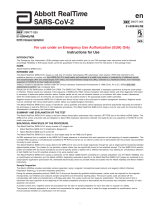
Clinic sta can contact Abbott Technical Support for any questions/diculty taking readings.
TIPS
• When taking the first reading in the recovery room, walk through the Take a Home Reading section of the Patient System
Guide with the patient.
• To experience the most benefit from the CardioMEMS™ HF System, it is important that the patient take readings
daily or as instructed by their physician. Taking readings should become part of their daily routine. It should only take
about 2–3 minutes.
• Many patients place the PES on their bed to take their readings.
• Once turned on, the PES takes a few minutes to warm up for use.
• There are three options for connectivity for the PES: cellular, Wi-Fi
‡
or landline. The PES will default to a cellular
connection. There is no cost to the patient for cellular service.
• If the patient does not have cellular coverage in their area, they can use Wi-Fi or landline connectivity. Refer the patient
to the QSG for instructions on how to connect to Wi-Fi or landline in their home.
TROUBLESHOOTING
• If the PES will not connect to the Merlin.net™ PCN when you are trying to pair the unit, take the PES to an outside
window to obtain a stronger cellular connection. If you are still unable to attain connectivity, reference the
Setup-No Wireless Connection Available section of the Hospital Electronics System Guide.
• Have the patient hold the handheld unit with the opposite hand from where their implant is located (i.e., right hand if
sensor is implanted on the left side). This helps to ensure the patient’s back, where the sensor is located, is flat against
the pillow.
• To avoid interference during a home reading, instruct the patient to:
– avoid placing the handheld unit directly on their chest during a reading.
– ensure that there are no metal objects near the PES. This could include jewelry, keys, belts, electric heating blankets,
metal bed frame or rails, or other medical equipment such as a continuous positive airway pressure (CPAP) machine,
hearing aid charger or oxygen supply.
• Have the patient take slow deep breaths if they are having trouble getting a strong signal strength. Breathing quickly or
taking really big breaths causes respiratory variability, making it hard for the system to get a strong signal.
• If the volume needs to be adjusted on the PES, select Options on the start screen of the handheld unit. Select Volume
and then toggle up or down to increase or decrease.
Abbott
The Corporate Village, Da Vincilaan 11 Box F1, 1935 Zaventem, Belgium
Tel: +32 2 774 68 11
SJM.com
St. Jude Medical is now Abbott.
Brief Summary: Prior to using these devices, please review the Instructions
for Use for a complete listing of indications, contraindications, warnings,
precautions, potential adverse events and directions for use.
™ Indicates a trademark of the Abbott group of companies.
‡ Indicates a third party trademark, which is property of its respective owner.
© 2018 Abbott. All Rights Reserved.
29388-SJM-MEM-0818-0434a | Information contained herein for
DISTRIBUTION outside of the U.S. ONLY. Check the regulatory status of the
device in areas where CE marking is not the regulation in force.
Germany +49 619 6771 1220
Switzerland +41 442 757 180
France +33 141 465 488
Netherlands +31 318 583 228
Belgium +32 2 200 6722
UK/Ireland +44 121 306 0550
Italy +39 039 607 4850
Denmark +45 4450 0388





